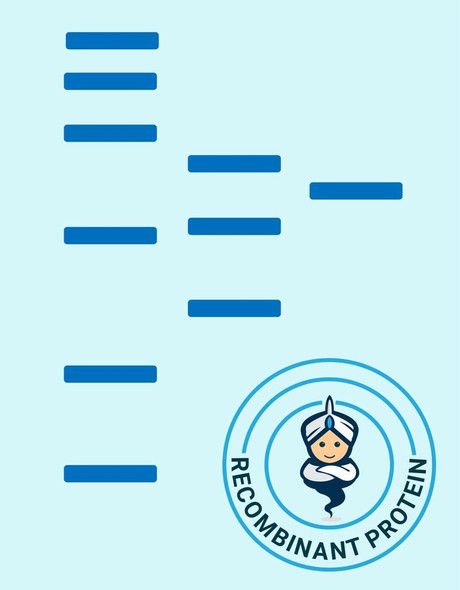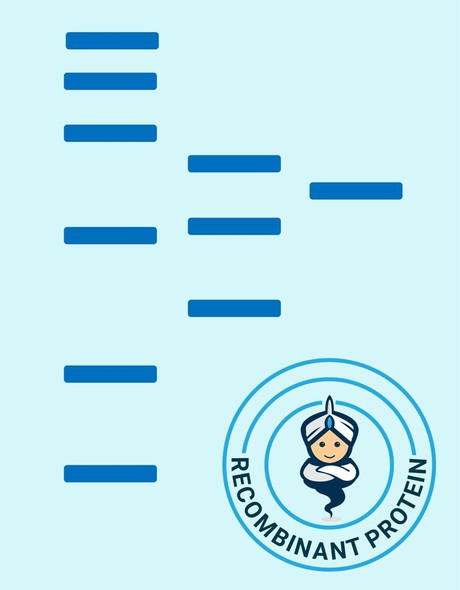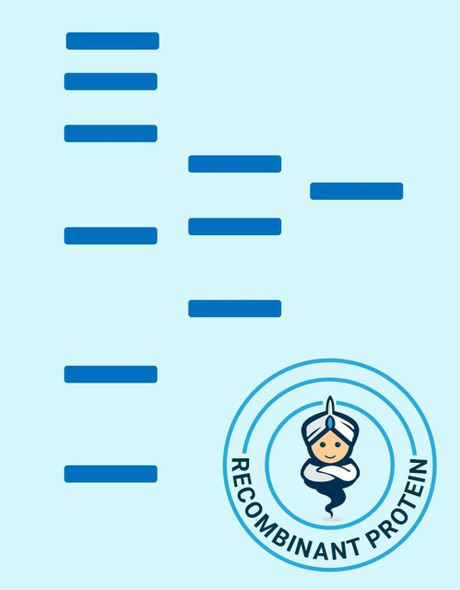Description
| Product Name: | Human TXN1 Recombinant Protein |
| Product Code: | RPPB5045 |
| Size: | 50µg |
| Species: | Human |
| Target: | TXN1 |
| Synonyms: | Thioredoxin, ATL-derived factor, ADF, Surface-associated sulphydryl protein, SASP, TXN, TRDX, TRX, TRX1, MGC61975, DKFZp686B1993. |
| Source: | Escherichia Coli |
| Physical Appearance: | Sterile filtered colorless solution. |
| Formulation: | Thioredoxin solution containing 1mg/ml solution containing 1xPBS pH 7.4. |
| Stability: | Store at 4°C if entire vial will be used within 2-4 weeks.Store, frozen at -20°C for longer periods of time.For long term storage it is recommended to add a carrier protein (0.1% HSA or BSA).Avoid multiple freeze-thaw cycles. |
| Purity: | Greater than 90.0% as determined by SDS-PAGE. |
| Amino Acid Sequence: | MVKQIESKTA FQEALDAAGD KLVVVDFSAT WCGPCKMIKP FFHSLSEKYS NVIFLEVDVD DCQDVASECE VKCMPTFQFFKKGQKVGEFS GANKEKLEAT INELV |
| Biological Activity: | Specific activity is>150 A650/min/mg, obtained by measuring the increase of insulin precipitation in absorbance at 650 nm resulting from the reduction of insulin. |
Thioredoxins are small disulphide-containing redox proteins (within the conserved Cys-Gly-Pro-Cys active site) that have been found in all the kingdoms of living organisms. Thioredoxin contains a single disulfide active site and serves as a general protein disulphide oxidoreductase. Thioredoxins are involved in the first unique step in DNA synthesis. It interacts with a broad range of proteins by a redox mechanism based on reversible oxidation of two cysteine thiol groups to a disulphide, accompanied by the transfer of two electrons and two protons. The net result is the covalent interconversion of a disulphide and a dithiol. It has been suggested that thioredoxin may catalyze the formation of correct disulfides during protein folding because of its ability to act as an efficient oxidoreductant. Trx also provides control over a number of transcription factors affecting cell proliferation and death through a mechanism referred to as redox regulation.
Thioredoxin Human Recombinant produced in E.Coli is a single, non-glycosylated, polypeptide chain containing 105 amino acids and having a molecular mass of 11.7 kDa.
| UniProt Protein Function: | TXN: Participates in various redox reactions through the reversible oxidation of its active center dithiol to a disulfide and catalyzes dithiol-disulfide exchange reactions. Plays a role in the reversible S-nitrosylation of cysteine residues in target proteins, and thereby contributes to the response to intracellular nitric oxide. Nitrosylates the active site Cys of CASP3 in response to nitric oxide (NO), and thereby inhibits caspase-3 activity. Induces the FOS/JUN AP-1 DNA-binding activity in ionizing radiation (IR) cells through its oxidation/reduction status and stimulates AP-1 transcriptional activity. Homodimer; disulfide-linked. Interacts with TXNIP through the redox-active site. Interacts with MAP3K5 and CASP3. In case of infection, interacts with S.typhimurium protein slrP. Interacts with APEX1; the interaction stimulates the FOS/JUN AP-1 DNA- binding activity in a redox-dependent manner. Up-regulated by ionizing radiation. Belongs to the thioredoxin family. |
| UniProt Protein Details: | Protein type:Nuclear receptor co-regulator Chromosomal Location of Human Ortholog: 9q31 Cellular Component: cytoplasm; cytosol; mitochondrion; nucleoplasm; nucleus Molecular Function:oxidoreductase activity, acting on sulfur group of donors, disulfide as acceptor; protein binding; protein disulfide oxidoreductase activity Biological Process: activation of protein kinase B; cell motility; cell proliferation; cell redox homeostasis; cell-cell signaling; nucleobase, nucleoside and nucleotide interconversion; positive regulation of DNA binding; positive regulation of peptidyl-serine phosphorylation; positive regulation of protein kinase B signaling cascade; protein folding; protein repair; regulation of protein import into nucleus, translocation; response to radiation; response to reactive oxygen species; signal transduction; sulfate assimilation |
| NCBI Summary: | The protein encoded by this gene acts as a homodimer and is involved in many redox reactions. The encoded protein is active in the reversible S-nitrosylation of cysteines in certain proteins, which is part of the response to intracellular nitric oxide. This protein is found in the cytoplasm. Two transcript variants encoding different isoforms have been found for this gene. [provided by RefSeq, Oct 2011] |
| UniProt Code: | P10599 |
| NCBI GenInfo Identifier: | 135773 |
| NCBI Gene ID: | 7295 |
| NCBI Accession: | P10599.3 |
| UniProt Secondary Accession: | P10599,O60744, Q53X69, Q96KI3, Q9UDG5, B1ALW1, |
| UniProt Related Accession: | P10599 |
| Molecular Weight: | 9,452 Da |
| NCBI Full Name: | Thioredoxin |
| NCBI Synonym Full Names: | thioredoxin |
| NCBI Official Symbol: | TXN�� |
| NCBI Official Synonym Symbols: | TRX; TRDX; TRX1�� |
| NCBI Protein Information: | thioredoxin |
| UniProt Protein Name: | Thioredoxin |
| UniProt Synonym Protein Names: | ATL-derived factor; ADF; Surface-associated sulphydryl protein; SASP |
| UniProt Gene Name: | TXN�� |
| UniProt Entry Name: | THIO_HUMAN |






